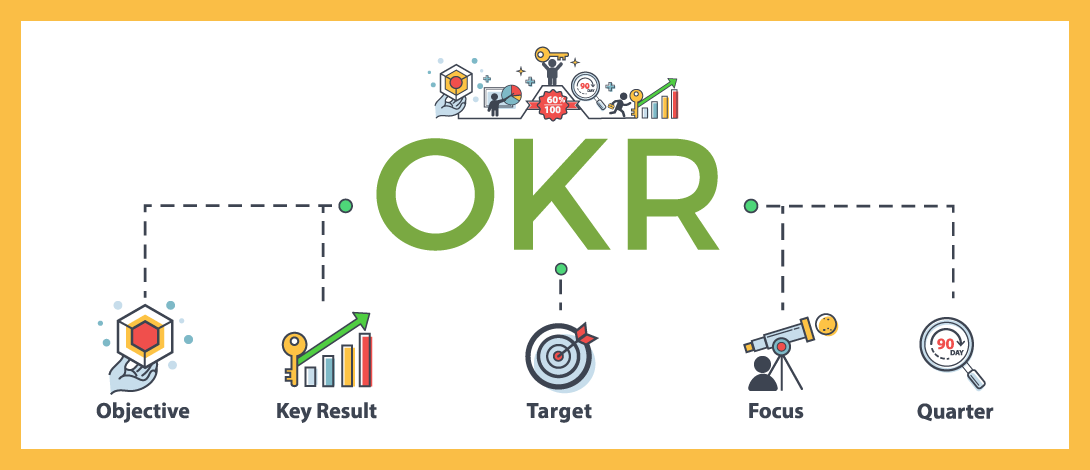06 Mar

Introduction
In this fast paced world, it has become more than essential for organizations — small or large — to have a defined strategy and accountability to ensure that all teams are aligned and focused on a common goal.
For a company to operate in an agile environment, team members need to be empowered to make their own decisions and have a clear understanding of what is required of them.
The need of the hour to continually adapt to changing requirements have given rise to the popularity of OKR goal-setting framework.
There are many other goal-setting methodologies such as Management by Objectives (MBO), Balanced Score Card (BSC) and many more. However, OKR seems to be the most popular when it comes to effectiveness.
The use of first OKR method was initiated by Andy Grove at Intel in the 1970s. But more recently, it has been made famous by Google, who owes its success to the OKR framework.
Following them, many other top leading companies like Netflix, Twitter, Dell, Dropbox and more, started using OKR. They rely on OKR to create a trusting environment where teams can perform their best and drive business results.
Check our blog : A short guide to Performance Management Approaches
So, what is OKR?
OKR or Objective and Key Results, is a popular leadership technique that helps organizations set, communicate, and track their goals.
It is a holistic approach towards management of goals and performance levels of employees at every level of the enterprise. It helps in creating better alignment and engagement around measurable goals, which is usually set every quarter.
Basically, OKR is composed of two components:
- Objective; which is qualitative and defines what one wants to achieve
- Key results; which are quantitative and define how you will measure progress towards the objective
Let’s look at an OKR example.
Objective
To increase profitability of the company
Key Results
- Revenue from online order of products to be increased by at least 5%
- 3% profit increase by optimizing the manufacturing process
- Operating costs to be reduced by 50K per store unit
As one can see, the Objective is broader whereas the Key Results are more specific and their progress indicates progress towards achievement of the Objective.

Benefits of OKR
OKR is considered as one of the best team management practices. It enables organizations to effectively set goals and track their progress. The following benefits will make you consider implementing OKR for your company:
- Better Alignment of Goals
OKR helps in maintaining a clear understanding of the company objectives and drive every team towards a common goal. In plain language, teams create shared OKRs so that it promotes extensive and smooth collaboration without overlapping each other’s tasks. It means that each team has different jobs, but they still share the same Objective.
The definition of success remains the same for all, and thus, managers and employees can align their tasks and goals with the corporate mission.
- Create Engagement
Employees are more likely to engage when they see real value and meaning in their work, especially the fact that their work is contributing to the overall organizational objective. They need to know that their work is contributing to achieving something big.
Many times, you will find employees complaining about their work not getting acknowledged. They simply get busy with their daily routine and lose sight of the direction of what they were doing in the first place.
OKR solves this issue by allowing them to set goals at individual as well as team/company level and create a link between them.
- More Focus
The best thing about OKR is that it allows teams to prioritize work that has the most significant business impact.
By using a weekly or monthly check-in cadence, the progress of goals is tracked regularly. In case any problems come up, or there has been a sudden change of plans, OKR allows them to quickly adjust and re-calibrate to new key results that need to be achieved first.
- Improvement in Performance Level
OKR is all about stretching goals. You may ask why.
OKR pushes organizations to strive for more than what they thought was possible in the first place, by putting a stretch in the overall objective. Typically, if you are able to hit 80% mark of those stretch goals, it speaks a lot more than 100% of non-aspirational goals.
- Increased Transparency
Transparency comes with open communication, and it can be hard to achieve if there is no clear path to communicating and monitoring the business goals.
Through OKR, the company goals are set and reviewed for a predetermined period of time. These objectives are then tracked and measured to ensure that everyone in the line of sight is working towards attaining a common goal. Since everyone knows what is expected of them, and every individual is working towards a common Objective, it brings more alignment and transparency to the workplace. It further removes any kind of confusion.
- Regular Feedback and Updates
Most of the organizations provide feedback to their employees only once in a year, i.e., during the year-end performance reviews. Thus, employees don’t get the chance to improve in between, if needed.
Since OKR requires constant updates and reviews of its objectives and primarily key results, it increases communication between employees, their co-workers, and managers. Thus, timely corrective measures can be easily spread over time, which are quite useful in terms of increased probability of achievement.

How to design your OKRs effectively?
The process of designing OKR begins by setting up objectives and key results.
- Drafting and Planning OKR
OKR framework recommends setting up of objectives with 3 to 4 key results at an individual, team and company level. It should follow the SMART principle, i.e., the goals should be – Specific, Measurable, Actionable, Relevant, Time-bound.
Furthermore, OKRs are typically set on a quarterly basis, in some cases more frequently or on a project basis. Have all the members put up their Objectives & Key Results on the review template and get it approved.
- Check Progress and Update Status
Once those objectives and key results have been established, you should have regular check-ins that are made public. This way, everyone stays aware of the progress and stays on track of their objectives.
Well, the success of OKR depends on the fact that everyone is clear on their part of achieving those goals. When you do weekly check-ins, you can assess if any priority shift is required, or any adjustments need to be made. This ensures that your members get through the quarter with confidence and increases their chances of completing their tasks.
- Scoring OKRs
At the end of every quarter, it’s crucial to grade OKRs. This is essential to help team members know how well they have performed in achieving their goals.
Team managers should have one-on-one meetings with their members and discuss the progress against objectives, how and what could have been done differently, and how they can perform better the next time. The whole process opens up a healthy conversation and helps the team and company grow.

OKR Best Practices
If you want to successfully implement OKR for your organization, there are certain guidelines you should follow. Some of which includes:
- Set a quarterly planning schedule
It’s important that you set your objectives on a quarterly planning cadence, and align them to larger longer-term goals. This way, teams stay focused on achieving short-term initiatives while also keeping an eye on the big goal.
- Establish weekly cadence
OKR should be part of your weekly routine. It should be ideally measured and updated weekly and form an integral part of the agenda in weekly meetings and one-on-one conversations. This ensures that teams remain proactive in completing their tasks.
- Set the right tone
Appoint internal OKR champions who will take long-term responsibility for the process. They will make sure that everyone on the team understands the core areas on which they need to focus their time.
- Build S.M.A.R.T. goals
OKR focuses on setting up goals that are SMART — specific, measurable, actionable, realistic, and timely. Besides, the whole process involves tracking and measuring the work done with all the focus on the results. That’s why every key result needs to be clearly quantifiable and measurable.
- Pay extra attention to alignment
OKR is all about setting objectives at an individual level that aligns with the common goal of the company. That’s why while setting goals and giving direction, ensure that you establish an alignment between different objectives at all the levels of organization.

Pitfalls to avoid while setting OKRs
OKR is a very simple and easy practice. However, organizations can make mistakes when introducing them.
Here are the top three common OKR pitfalls that people usually commit, which need to be avoided.
Mistake #1: Keeping OKR Private to Individuals
The whole idea of OKR is to promote autonomy and transparency in the workplace. And that is only possible if everyone’s goal is clear to each other. If the goal setting is done in private, the team won’t know what is being contributed by individuals. It might also result in redundancy of key results.
Mistake #2: Setting too Many OKRs
You need to remember that OKRs are not your to-do list.
Each objective needs to have a maximum of 3 to 4 key results. You can then prioritize them and try to achieve them in order. The lesser important ones can be moved forward for the next quarter, or you can even remove them if they become irrelevant.
Setting up too many objectives can overwhelm employees, and they might end up achieving much less under undue pressure.
Mistake #3: Creating Unmeasurable Goals
OKR is about setting SMART goals that can be easily measured.
The key results had to be measurable in a quantitative manner. If you aren’t able to measure it, you would never know whether you are achieving the target or not.
Mistake #4: Setting Only Top-Down Objectives
Some of the goals in OKR are cascaded down from top to bottom. However, it’s also true that the team itself should define 60 percent of the OKRs. Giving some level of autonomy to the team members motivates and encourages them to strive towards success.
Mistake #5: Poor Resource Allocation
While setting up OKR, another pitfall to avoid is the improper allocation of resources. Asking employees to achieve something without appropriate resources can be the worst mistake one can make. It will only fuel resentment amongst employees when they aren’t able to complete their tasks for lack of resources.

What to look for in an OKR Technology Platform
When companies start using OKR, they begin by using manual tracking processes such as google docs, spreadsheets, and more. Soon enough, they outgrow these manual methods and look for a platform that can help them scale.
Here are a few things that you should look into when selecting the right OKR platform for your business:
- Ease of Use
When a performance management system is easy to use, it increases the success of adoption rate. Not only that but it also directly impacts the longevity of the system within a company. Make sure to choose the software that keeps you organized.
- Functionality
Another critical thing to check in a performance management tool is its functionality. You need a robust set of features to implement OKR into your workflow successfully. Some of these include the ability for managers and other team members to request feedback, reminders for weekly check-ins, and keep track of every individual’s progress. It will keep employees engaged.
- Support Employees at an Individual Level
You need to find a platform that allows you to set goals in the OKR style. Every goal-setting method has its own technique, and thus, not every performance management platform is meant for OKR implementation.
Find a system that allows you to create quantitative and qualitative targets for key results at an individual level for each employee.
- Flexibility
OKR brings flexibility to the whole process of setting up goals and easily adapt to the changes as situation demands. That’s why the performance management system that you choose should have the ability to allow you to restructure your goals midway. Besides, it should enable you to align your goals across organizations regardless of the structure.

Conclusion
What makes an organization agile is its ability to quickly adapt to the changes when more valuable opportunities show up.
With weekly or monthly check-in cadence, organizations are able to track the progress regularly. It allows them to prioritize work and quickly adjust to new key results if the situation demands.
Thus, OKR brings flexibility to the whole management system. Besides, it is quite easy to implement.
OKR has become one of the most popular management tools that successfully drives your business towards growth. Whether you want to drive performance or implement a new change, OKR can be your solution. Some of the new age technology companies have successfully leveraged OKR techniques.
Key Takeaways
The benefits of implementing OKR technique into your business are enormous. Some of which includes:
- Better alignment of goals
- Creating Engagement
- More focus
- Improvement in Performance Level
- Increased transparency
- Regular feedback and updates



